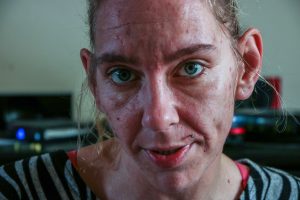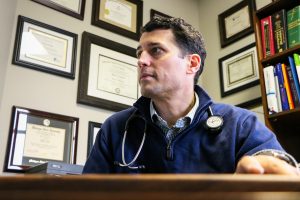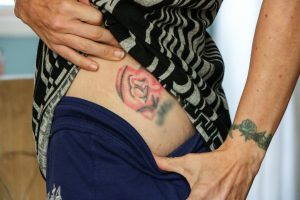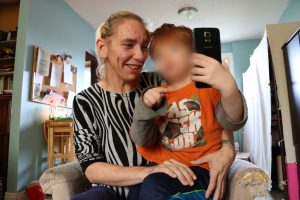Life in the time of opioid addiction in Windsor, Ont.

Stephanie Bertrand has been fighting a 16-year battle with addiction. Her greatest fear has been losing her four children. Stephanie’s home, Oct. 27, 2017, Windsor, Ont.
The front door of a middle-class Canadian suburban home yawns open, late on a weekday morning. The frail figure of a woman beckons me in. Clinging to her leg in the musty smelling hallway is a redheaded toddler who looks suspiciously at the visitor.
Stephanie Bertrand is a 36-year-old woman from Windsor, Ont. On her bony wrist sits a fading blue flower tattoo, the same shade as her eyes. Her skin carries deep blemished scars and when she smiles she reveals a set of brittle, decaying teeth.
Since the age of 22 she’s been exchanging vicious blows with her never-tiring arch rival. Addiction.
“It takes over every aspect of your life,” says Bertrand. “There is nothing more important than it. Even my own children.”
For 10 years, she’s been knocked down several times. Every time it takes more courage and strength to get up.
Her resolve to keep fighting has deteriorated drastically. She’s had numerous attempted suicides. She had to kick her husband out on the street and also deal with the constant fear of Children’s Aid workers walking in at any moment and taking her four children.
About a year and half ago opioid abuse in Windsor moved up to crisis level. Health care and law enforcement agencies had to scramble to keep people alive. A comprehensive strategy was rolled out. It addressed drug abuse in a way few ever thought possible.
It has been the life-line Bertrand needed.
Bertrand has her life and children for now thanks to the strategies prompted by the opioid crisis. Whether these emergency strategies will be successful and whether Bertrand has the staying power to see her rehabilitation through, depends on an entire community’s ability to shift perspectives.
Implementing and selling the harm reduction strategy
In October 2016, Ontario’s Ministry of Health released its first comprehensive opioid strategy. A year later, local authorities followed suit with the Windsor Essex Community Opioid Strategy.
The provincial strategy proposed to, “develop an evidence-based harm reduction framework … which has demonstrated to save lives and reduce costs within the health care system.”
Harm reduction entails providing addicts with services to help monitor and reduce their intake.
Both plans were drafted with input from a broad spectrum of community groups and individuals. In effect, the responsibility of not only finding solutions but implementing them, was shifted strongly into the community’s hands.
Privately funded community organizations form a big part of both plans.
The AIDS Committee’s needle exchange program is already initiated in Windsor, distributing 600,000 free units a year. The feasibility of supervised injection services is being investigated.
To make the general public buy into harm reduction, authorities are faced with the mammoth task of de-stigmatizing addiction. Harm reduction’s basic premise is accepting drug use, “to be primarily recognized as a health issue rather than a criminal matter,” according to the Windsor Essex Community Opioid Strategy.
Until a bit more than a year ago, the effects of opioid addiction simply weren’t that visible in Windsor, says Sarah Cipkar, community coordinator of Downtown Windsor Community Collaborative.

The Downtown Mission. This shelter for homeless people aids its guests with a variety of services and programs. Windsor, Ont.
Even though the downtown area is the last stop for addicts who’ve lost everything due to the high density of shelters and care facilities, it doesn’t paint an accurate picture of actual numbers.
“There are a lot of people that live with this addiction in their everyday life but they might not be on the street,” says Cipkar.
Overwhelming numbers of calls about “a person in the alley shooting up” or “being in mental or physical distress” have placed major strain on police resources.
Steve Betteridge, public information officer for Windsor Police Services says, “we are almost on a daily basis dealing with people in crisis who are dealing with addictions.”
Betteridge confirms that a shift has taken place from a mandate of arrest to, “getting them to a hospital and getting them treatment.”
The complicated nature of policing drugs becomes evident when the police follow up on incidents where they react to drug-related incidents.
“A lot of our people in crisis, when we get to speak to them, our investigations determine that it was legitimately obtained through a medical prescription,” he says “and over time an addiction has developed.”
Healing an addict’s body…and spirit

Addiction medicine specialist Dr. Peter Farago at his clinic on Tucemseh Road E., Windor, Ont. Tuesday, Oct. 31, 2017
Dr. Peter Farago is an addiction medicine specialist who prescribes opioid substitution treatments like the tamper free Suboxone on a daily basis. He also provides lifesaving Naloxone kits that prevent overdosing .
“Harm reduction entails setting goals of reducing intake,” says Farago. Going cold turkey doesn’t work well. Studies show that after five years, only five to 10 per cent of addicts remain drug free.
Synthetic opioids, like fentanyl, are not dangerous nor addictive if administered and monitored correctly he notes. In controlled conditions, people live completely normal, pain-free lives. It’s also invaluable in emergency care.
“If you crash your car into a pole and fracture your leg, you’d better damn well get an opioid at that ER, because that is what it’s going to take to handle that pain,” says Farago.
Doctors prescribe opioids in non-acute settings because they’re sympathetic, he admits. The harm reduction strategy also proposes the implementation of monitoring systems and information sessions for doctors.
Several high-strength formulations of opioids have been delisted from the Ontario Drug Benefit Formulary, according to the Ontario Minister of Health.
Bertrand’s story starts at a time before harm reduction when such a strategy would probably have been considered a recipe to bring about complete public disorder.
The harm before harm reduction

Stephanie shows off one of the tattoos her customers at the bar where she stripped, loved. Windsor, Ont. Oct. 27, 2017.
Stephanie Bertrand ploughs down on a weathered couch and takes a deep drag from her vaporizer she calls “Big Boy.” Part of her twofold Methadone Maintenance Treatment/cognitive behavioural therapy is advocacy, so she’s doing this interview.
She says an unplanned pregnancy led to an early marriage. She and the father felt it was the right thing to do.
They had two children together but the marriage didn’t last. She got custody of her two children and had to provide for them so she worked as a stripper.
Drugs were readily available. It helped her cope with the job.
“I started taking cocaine when I was 22. My marriage was falling apart. My family was falling apart. I was feeling completely inadequate with myself and the only thing that made it feel better was cocaine.”
One evening four years later, after a drug binge, she was feeling so hopeless she decided to end her life.
“I went down to the river. I climbed over the railing and I was ready to jump in. I was ready for the undertow to take me,” she recalls. Miraculously, a random stranger spotted her and talked her off the river’s edge at 4 a.m. She never saw him again.
In reaction, her ex-husband took their two children for two weeks. Along with her attempted suicide it served as a sobering wake-up call. That’s when she decided to tattoo their names on the inside of her wrists. She wanted to see that so that she’d think twice if she were to cut a line of cocaine again.
“But it didn’t work. I couldn’t even do it for my kids. That hurt me. Really hurt me.” She cleaned up for a brief spell and got her two children back.
“Finances went down the drain and I couldn’t afford to feed my kids, so I ended up going back to the bar doing the same job which eventually led to the same problem,” she said.
This time she supplemented her income by dealing drugs as well.
“That wasn’t a good idea,” she says, “because I ended up getting robbed.”
That fight she actually won. In fact, she got up from the ensuing brawl, went home and got clean for a whole year.
Then, her second husband stumbled into her life. He was a one-night stand that “stuck around,” but he was an addict and a thief. He introduced her to synthetic opioids, or “the little green monster.”
For years they tag teamed on who would keep the household afloat. “He’d steal anything that wasn’t nailed down.” The pressure of the relationship became too much.
When she was eight months pregnant with her fourth child she couldn’t suppress her addiction any longer.
“I’m not going lie. Near the end I just couldn’t do it anymore. My addiction took over,” she confesses. “I’m lucky he’s okay.”
Then three years ago, at Thanksgiving, her life bottomed out.
Her husband was late in collecting his Methadone treatment on a Friday so he would have to go without his fix for an entire weekend. Stephanie witnessed a weekend of withdrawals she thought would cost him his life. Shortly after, he started doing crystal meth.
“He would be seeing things, hearing things. It was the scariest thing. I’ve been through a lot of things with the drugs, but that scared me.”
She woke up one morning with a fright, cutting herself on the butcher knife he held in his hands while sitting on the bed next to her. He was seeing things and couldn’t make the voices stop.
“I took him to the hospital and they said, ‘oh no, he’s an addict, you need to take him to rehab.’ The rehab would say, ‘oh no, he’s got mental issues, you need to take him to the hospital.’ Neither one of them would help him.” Bertrand becomes quite besides herself as she recalls the event.
It became a week-long horror saga. Meanwhile, police were involved and along the way CAS entered the picture.
The motivational force that is Children’s Aid Society

Stephanie at home with her fourth child. Windsor, Ont. Oct. 28, 2017
The first time CAS opened a file on her, “I got them out in 16 months,” she says. “The second time they stuck around for three years.”
Not surprisingly, Bertrand has nothing but contempt for the organization.
In the past, a court sanctioned order stipulating conditions for an addicted mother to keep her children, would need to be followed to the letter. This left little room for aid workers on how to implement it.
Lee Ann Ford, family services supervisor at CAS says they realized in cases where an element of drug abuse was present, a type of court was needed that took a deeper and more caring approach.
Ford and her team initiated change by allowing for, “expansion of access if the parent is working towards recovery in treatment and doing well.”
They actively started pursuing ways in which court orders could be implemented that maximized the parent’s motivation to recover.
They want to provide services faster, even if that meant they would have to “take the parent’s hand and guide them.”
The more flexible approach coincides with the implementation of harm reduction strategies.
“A lot times I find that if the child is removed from the parent’s care, they really don’t have that motivation (to go clean),” says Ford. “It’s really hard for them to get their child back based on their addiction.”
Despite challenges, Ford and her team’s approach are paving the way for the Family Treatment Court, which is going to be similar to the U.S. equivalent.
This type of court will allow parents struggling with addiction to follow a recommended 12-month program allowing for weekly consultations with a judge. A Family Service worker would attend these meetings, advocating for the parent based on their progress. This allows for closer monitoring to determine the overall effectiveness of the orders.
“My children are my life. They’re the only reason I’m still here,” Bertrand confesses. She was still at the bar stripping. “I was sick of stripping, I was sick of talking to guys. I was sick of it all. I looked myself in the mirror and I said, ‘You need to fix yourself NOW!’”
A year back Bertrand took the final two steps in cleaning up her life. First, she kicked her husband out of her house. She says her daughter cries all the time.
“She doesn’t see him, but she knows he’s sick,” she says. “He’s still out on the street and it’s been a year and the snow is coming. It breaks my heart every day.”
She had been going for counselling at House of Sophrosyne and Hiatus House on and off for years. She didn’t share the extent of her problem out of fear they would tell CAS.
Then she took the second and final step to recovery. “I dealt with it pretty much on my own for a long time until I went to doctor Farago.”
Harm reduction’s give and take
Unlike other doctors who Bertrand says treated her like a junkie, Dr. Farago was compassionate and understanding. He assured her everything shared would stay between the two of them. Her harm reduction treatment included a moderate starting dose of 16mg of Seboxone and opening channels to her cognitive behavioural therapy coordinators.
Bertrand is down to 6mg. Foolishly she tried to reduce her dosages on her own twice, but quickly returned to the prescribed dosages.
She’s anxious to go clean and there aren’t as many supports for her as for some other addicts – she is not eligible for Narcotics Anonymous.
“You are not considered clean if you are using methadone maintenance treatment. You cannot get key tags. You do not get to acknowledge clean time,” she declares dejectedly.
The holistic make-up of harm reduction therapies sees Bertrand utilising a multitude of avenues to receive and give support. She often chats on online support forums. She’s become a born again Christian through a program called Celebrate Recovery. Her counsellor from House of Sophrosyne is on her speed dial and she’s started an outreach and advocacy group called Angels of Hope.
They’re a collective of recovering addicts. They distribute Blessing Bags. It consists of donated sanitary products, socks and information leaflets for users left “out in the cold.”
She even assists in picking up improperly discarded needles in downtown alleyways despite the fact that each one she touches could trigger a relapse.
“It’s like a Pavlov’s dog’s response. It’s ridiculous. (And) everyone (needle) I pick up would send a bubble right here (pointing to her throat).
Bertrand has been on 6mg of Suboxone for three months and wants off. The final drop is lying ahead and she’s frank about how it makes her feel. “It scares the daylights out of me. I’ve heard so many horror stories.”
I could see the reality she confronts daily weighing in on the bed of confession she just made. She pinches her bottom lip with two fingers and looks up.
“I’m doing good. Everything in life is actually going like things in life are supposed to go for a change. I don’t know if that makes sense.”


